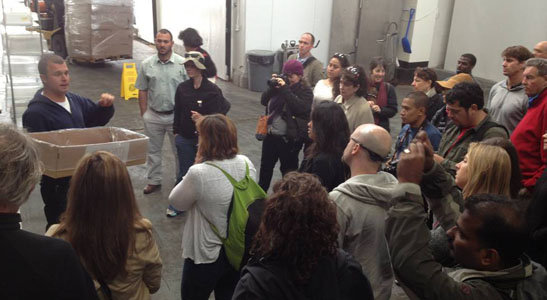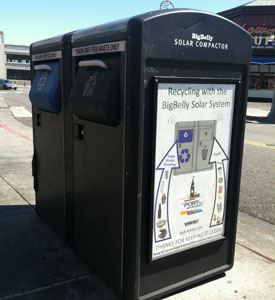Fisherman’s Wharf is well on its way to meeting its ambitious goal of achieving zero-waste by 2017.

Local fishing outfit Two X Sea is one of the Wharf’s shining stars when it comes to sustainability. Tours like the one pictured are given to showcase the company’s sustainable practices. Photo courtesy of L2 Environmental
By Bill Picture
Published: July, 2013
The wharf’s bustling mix of restaurants, shops, hotels and entertainment establishments draws an estimated 14 million visitors each year. Consider the amount of waste generated by those visitors, then add to the waste stream the packing materials, food scraps and other discarded items generated by the over 120 businesses that serve them, and you’ll understand why one of San Francisco’s most visited attractions also has the potential to be one of the City’s trashiest.
Recognizing these basic facts, the Fisherman’s Wharf Community Benefit District (FWCBD) hired sustainability consultants L2 Environmental in November 2010, and L2 has been a driving force behind the green changes.
"When we started, we knew that getting a buy-in from management was going to be key," said L2 founder Leslie Lukacs. "One of the major challenges at Fisherman’s Wharf is the high employee turnover. It’s a seasonal place. That means that training has to be ongoing, to capture new employees. And sustainability has to be integrated by management into standard business practices."
Still, Lukacs says the first step undertaken was an obvious one—making sure every business had access to compost and recycle bins to minimize the amount of landfill-bound waste. For one block of businesses that shared a trash compactor into which they had been tossing all of their waste, for example, that meant completely re-learning how to take out the trash.
"We painted the trash compactor blue for recycling, and gave them a three-cubic-yard container for compost, and one for garbage. Then we scheduled several trainings and asked that the businesses make it mandatory for their staff to attend at least one of the trainings," Lukacs said.
Just as important as having the right equipment is having the knowledge to go with it, according to Lukacs, whose firm was paid using Zero-Waste Grant Program money awarded to the FWCBD by San Francisco Department of the Environment. The Zero-Waste Grant Program awards money in a two-year cycle to nonprofit organizations in San Francisco that are working toward zero-waste goals. The program is a partnership between the City of San Francisco and Recology, which partners with grant awardees. Many of the educational materials that Lukacs uses are provided by Recology.
"When you put out the ‘fantastic three’"—that’s what the three-bin system for landfill, recycling and compost has affectionately been named in San Francisco—"it’s important that the bins are accompanied by educational material," Lukacs said. "And Recology’s signs are great because they include pictures of what items should be deposited into each bin, so a lot of the guesswork is taken out of it for you."
Still, we all periodically find ourselves standing in front of the bins with trash in our hand, unsure which bin to use. And because we can’t quickly find the item in any of the photos, we just choose a bin and hope for the best. "That’s why in-person training is important," Lukacs said. "We can answer questions."
Lukacs reported that the most frequently asked question during trainings is still about where to put coffee cups from Starbucks. "And I point at the signs from Recology and say, ‘Cups go into compost, and lids go into recycling,’" she said. "It’s right there on the signs."
High-tech trash collection
To step up its zero-waste game, the FWCBD partnered with the Port of San Francisco to invest in high-tech public trash receptacles. The conventional trash receptacles on the block of Taylor Street near Pier 45 were replaced with two BigBelly Solar bins—one for recycling and one for trash—that use solar power to compact the waste inside them and have a built-in computer that allows for remote monitoring.
"We can go online and see when the bins are full," Lukacs said. "These bins also save on labor because compacting what’s inside means a bin only has to be emptied once a day instead of seven times."
Compacting the contents of the bins also prevents them from being rifled through by can-and-bottle collectors, who have a bad habit of picking out the cash-redeemable items and leaving behind a mess. "So the area surrounding the BigBelly bins is much cleaner," Lukacs said.
The FWCBD and the port have been keeping a close eye on the BigBelly bins to see if people are using them correctly, and Lukacs reports that the contamination rate is below 10 percent. So impressed were the partners by those results that they recently embarked on a new pilot program, installing a third BigBelly Solar bin for composting at two bin clusters in the area.
"It’s the first time there’s ever been public organics collections on the street," Lukacs said. "Organics is hard because the amount of contamination that it takes to ruin the whole thing is much, much smaller. So we’re watching very closely to see how it goes."
The "shining stars" of Fisherman’s Wharf
Lukacs reported that efforts to achieve zero-waste at the wharf have generally been well-received. In fact, a few businesses have already implemented zero-waste strategies on their own and are being used by Lukacs as in-action how-to’s. "Scoma’s, for instance, is the shining star down at the wharf," she said. "They’ve had a 90 percent diversion rate for the last eight years now."
"And that’s because their owner is 100 percent committed to zero-waste. They’re always looking for ways to minimize waste and when they purchase for the restaurant, being conscious of not creating waste."
Lukacs believes that seeing Scoma’s waste diversion tactics in action is more effective than any textbook or speech she can give, so she organizes tours of the restaurant for other area businesses. She says this is especially helpful for other restaurants, whose staff members get a chance to engage with members of their own industry. "Peer-to-peer, I think this knowledge carries more weight," she said.
It’s a strategy she hopes to employ in the near future as she tries to enlist the support of local fisherman in the wharf’s zero-waste efforts. They’ve proven a tough nut to crack; but she’s hoping that one sustainability-minded fishing outfit, Two X Sea (TXS), can help.
"They believe, ‘If fishing is our livelihood and we know that some fish have collapsed, then as fisherman shouldn’t we be fishing in a sustainable way so that we have oceans to fish?’" Lukacs said. "But not every fisherman buys into that thinking."
On Lukacs’ to-do list is organizing peer-to-peer tours of Two X Sea for other fish processors to share TXS’s sustainable practices, including replacing cardboard boxes for delivering fish with reusable plastic containers. "I’ve met with the fisherman several times and done trainings and we’ve made some headway," she said. "Peer-to-peer is the next step."
Overall, Lukacs says she’s very happy with the progress that’s been made, and proud to be helping Fisherman’s Wharf and San Francisco reach its shared zero-waste goal. "I’m on the board of the Zero-Waste International Alliance," she said, "and this year, San Francisco hosted Zero-Waste Week. Seventy people took a tour of Fisherman’s Wharf, and they were very impressed with what we’re doing. San Francisco is a leader on the international level, and people are really looking at the City as a model."
For more information on the Fisherman’s Wharf Community Benefit District’s Zero-Waste Initiative, visit www.visitfishermanswharf.com/about-the-wharf/zero-waste-initiatives.

The Fisherman’s Wharf Community Benefit District set a goal of being zero-waste by 2017, which would put it three years ahead of the citywide zero-waste deadline established by the San Francisco Board of Supervisors in 2002. Photo by Bill Picture

As part of its effort to achieve zero-waste, the Fisherman’s Wharf Community Benefit District partnered with the Port of San Francisco to replace conventional waste receptacles with BigBelly Solar bins (pictured) for recycling and garbage. Photo by Bill Picture

